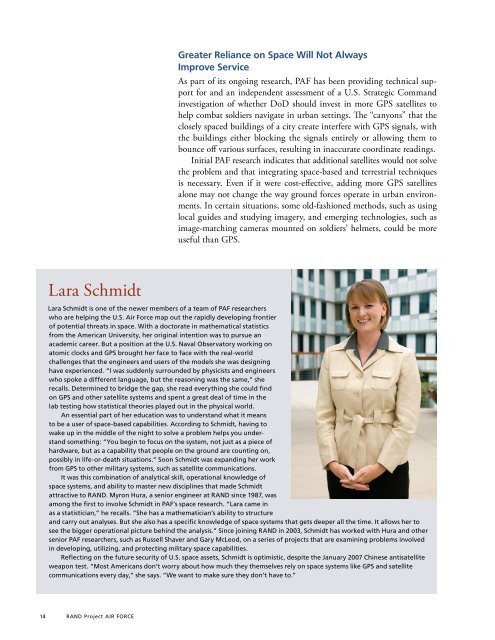RAND Project AIR FORCE Annual Report 2007 - RAND Corporation
RAND Project AIR FORCE Annual Report 2007 - RAND Corporation
RAND Project AIR FORCE Annual Report 2007 - RAND Corporation
You also want an ePaper? Increase the reach of your titles
YUMPU automatically turns print PDFs into web optimized ePapers that Google loves.
Greater Reliance on Space Will Not AlwaysImprove ServiceAs part of its ongoing research, PAF has been providing technical supportfor and an independent assessment of a U.S. Strategic Commandinvestigation of whether DoD should invest in more GPS satellites tohelp combat soldiers navigate in urban settings. The “canyons” that theclosely spaced buildings of a city create interfere with GPS signals, withthe buildings either blocking the signals entirely or allowing them tobounce off various surfaces, resulting in inaccurate coordinate readings.Initial PAF research indicates that additional satellites would not solvethe problem and that integrating space-based and terrestrial techniquesis necessary. Even if it were cost-effective, adding more GPS satellitesalone may not change the way ground forces operate in urban environments.In certain situations, some old-fashioned methods, such as usinglocal guides and studying imagery, and emerging technologies, such asimage-matching cameras mounted on soldiers’ helmets, could be moreuseful than GPS.Lara SchmidtLaraSchmidtisoneofthenewermembersofateamofPAFresearcherswhoarehelpingtheU.S.AirForcemapouttherapidlydevelopingfrontierof potential threats in space. With a doctorate in mathematical statisticsfrom the American University, her original intention was to pursue anacademiccareer.ButapositionattheU.S.NavalObservatoryworkingonatomic clocks and GPS brought her face to face with the real-worldchallenges that the engineers and users of the models she was designinghave experienced. “I was suddenly surrounded by physicists and engineerswho spoke a different language, but the reasoning was the same,” sherecalls. Determined to bridge the gap, she read everything she could findonGPSandothersatellitesystemsandspentagreatdealoftimeinthelab testing how statistical theories played out in the physical world.Anessentialpartofhereducationwastounderstandwhatitmeanstobeauserofspace-basedcapabilities.AccordingtoSchmidt,havingtowakeupinthemiddleofthenighttosolveaproblemhelpsyouunderstandsomething:“Youbegintofocusonthesystem,notjustasapieceofhardware, but as a capability that people on the ground are counting on,possibly in life-or-death situations.” Soon Schmidt was expanding her workfrom GPS to other military systems, such as satellite communications.It was this combination of analytical skill, operational knowledge ofspace systems, and ability to master new disciplines that made Schmidtattractiveto<strong>RAND</strong>.MyronHura,aseniorengineerat<strong>RAND</strong>since 1987,wasamong the first to involve Schmidt in PAF’s space research. “Lara came inasastatistician,”herecalls.“Shehasamathematician’sabilitytostructureand carry out analyses. But she also has a specific knowledge of space systems that gets deeper all the time. It allows her tosee the bigger operational picture behind the analysis.” Since joining <strong>RAND</strong> in 2003, Schmidt has worked with Hura and otherseniorPAFresearchers,suchasRussellShaverandGaryMcLeod,onaseriesofprojectsthatareexaminingproblemsinvolvedin developing, utilizing, and protecting military space capabilities.Reflecting on the future security of U.S. space assets, Schmidt is optimistic, despite the January <strong>2007</strong> Chinese antisatelliteweapontest.“MostAmericansdon’tworryabouthowmuchtheythemselvesrelyonspacesystemslikeGPSandsatellitecommunications every day,” she says. “We want to make sure they don’t have to.”14 <strong>RAND</strong> <strong>Project</strong> <strong>AIR</strong> <strong>FORCE</strong>
















